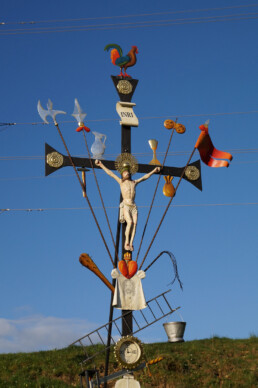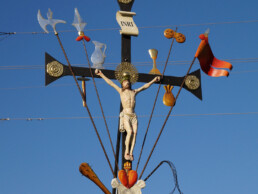Foundation Wegzeichen („Signposts“) offers prize
The Foundation Wegzeichen–Lebenszeichen–Glaubenszeichen („Signposts–Signs of life–Signs of faith“) is offering the Foundation Award 2021 for outstanding activities for the preservation, construction or documentation of Christian signs of the way in the Diocese of Rottenburg-Stuttgart.
Prize-worthy activities are, for example:
- Activities to safeguard and preserve a small religious monument
- Restoration and renovation work
- Documentation of small religious monuments on site or in the region
- Questioning the owners of small religious monuments about the history of a small monument, the motivation of the builders, etc.
- Films/videos/sound documents on the subject
- New construction of a small religious monument
The commitment of young people to religious waymarks is rewarded with a special prize. They are called upon, for example, to look into the wayside signs in their locality or to think about erecting a new religious sign.
Individuals, groups or associations can apply for the prize, but not church or political communities or official institutions. The project proposed for the award must have been completed at the time of application (but no longer than 2 years!) and be located on the territory of the Diocese of Rottenburg-Stuttgart. Unfortunately, projects that have already received a funding grant from the Wegzeichen Foundation cannot be considered for an application for the Foundation Award.
You can find detailed information here.

Song Recital - Livestream
"The Soul's Long Journey"
Life tells the most diverse stories. However, the feeling of happiness, love, pain and suffering is common to all. As a listener, consider the lyrical I in songs by Schubert, Schumann, Mahler and others, and accompany it through different life situations, culminating in the God-given arrival in the “Saviour’s dwelling place”, paradise.
Musical arrangement:
Andreas Großberger, tenor
Jens Wollenschläger, piano
Duration: approx. 45 minutes
Registration is not necessary.
You can find the link to the livestream directly on the Youtube channel of the Diocesan Museum.

Andreas Großberger, Tenor

Prof. Jens Wollenschläger, piano
In unserer Erde. Grabfunde des frühen Mittelalters
Unter dem Titel “In unserer Erde. Grabfunde des frühen Mittelalters” präsentiert das Diözesanmuseum in Rottenburg seit dem 18. Oktober 2020 einzigartige Kunst- und Gebrauchsgegenstände aus der Zeit zwischen dem 5. und 7. Jahrhundert. „Mit teils bislang der Öffentlichkeit nicht vorgestellten Objekten zeigen wir den Besucherinnen und Besuchern die Vielfalt an kulturellen Identitäten dieser Epoche“, sagt Museumsleiterin Dr. Melanie Prange.
Die Jahresausstellung vereint Fundstücke aus den reichhaltig und oft vollständig erhalten gebliebenen Sülchen-Gräbern bei Rottenburg sowie Exponate der archäologischen Sammlungen des Landes Baden-Württemberg. Am Übergang zum Christentum steht das Frühmittelalter dabei als Epoche des Wandels, die von Mobilität, Austausch sowie der Vernetzung unterschiedlicher Kultur- und Glaubensräumen geprägt war. Die Ausstellungsbesucher können sich so auf byzantinische Schmuckobjekte, burgundische Fibeln, langobardisch geprägte Goldblattkreuze oder auch auf Bernsteinfunde aus Nordeuropa freuen.
Die mit ältesten ausgestellten Zeugnisse christlichen Lebens im Südwesten stammen aus den Grabungen bei der Sülchenkirche, ein im süddeutschen Raum einzigartiger Platz, der seit dem 6. Jahrhundert ununterbrochen als Bestattungsort genutzt wird und auf dem Archäologen bislang rund 300 Gräber fanden, von denen etwa 80 auf das frühe Mittelalter datieren. Zu sehen gibt es im Diözesanmuseum aber auch andere einzigartige Kostbarkeiten wie die Beigaben des sogenannten „Schwenninger Frauengrabs“ aus dem frühen 6. Jahrhundert.
„Die zum Teil singulären Artefakte führen uns vor Augen, dass unsere Vergangenheit immer noch unbekannte Seiten hat. Immer wieder gibt die Erde Schätze preis, die neue Blicke auf uns scheinbar bekannte Epochen ermöglichen“, fasst Museumsleiterin Dr. Prange zusammen. Anhand des Gräberfelds in Sülchen und der ebenfalls dort entdeckten drei Vorgängerbauten der heutigen Sülchenkirche wird zum Beispiel deutlich, dass die Siedlung vom Frühmittelalter bis mindestens in die Zeit der Ottonik eine zivilisatorische Bedeutung für das Umland besessen haben muss. Viele Sülchener Grabbeigaben zeigen dabei fränkische oder burgundische Einflüsse, so etwa eine Zierscheibe aus einem Mädchengrab (Mitte 6. Jh.), die in dieser Form in Nordostfrankreich in Mode war. Die Waffenausstattung der Männergräber ist in Sülchen im Vergleich zu anderen Orten der näheren Umgebung reduziert, weswegen die Siedlung als administratives Zentrum unter fränkischer Herrschaft interpretiert wird. Unter den wenigen Waffen, die gefunden wurden, befinden sich jedoch archäologische Highlights z. B. ein Kurzschwert, dessen außergewöhnlich gut erhaltene Lederscheide zeigt, wie aufwendig Gebrauchsgegenstände gestaltet und verziert wurden.
Dokumentarfilm »Die Sülchenkirche« feiert Premiere
Die 120 Zuschauerinnen und Zuschauer genossen die stimmige Open-Air-Atmosphäre an diesem Spätsommerabend sichtlich und zeigten sich hernach beeindruckt von der reichen Geschichte Sülchens.
Der Film von Regisseur Dominik Wessely verdichtet in 45 Minuten ein breites Themenspektrum. Es geht um die archäologischen Funde, die bei den Ausgrabungen in Sülchen in den vergangenen Jahren gefunden wurden und die unter anderem Aufschluss geben über die frühchristliche Bestattungskultur vor 1400 Jahren. Die Dokumentation zeigt aber auch das Geheimnis der Entstehung der Sülchenkirche und die Geschichte der Christianisierung des Südwestens.
Nach der Premiere sprachen Bischof Gebhard Fürst (auf dem Podium) und Regisseur Dominik Wessely (live aus Berlin zugeschaltet) vor dem Publikum mit Bischofsreferentin Karin Schieszl-Rathgeb über Motivation und Entstehung des Dokumentarfilms.



